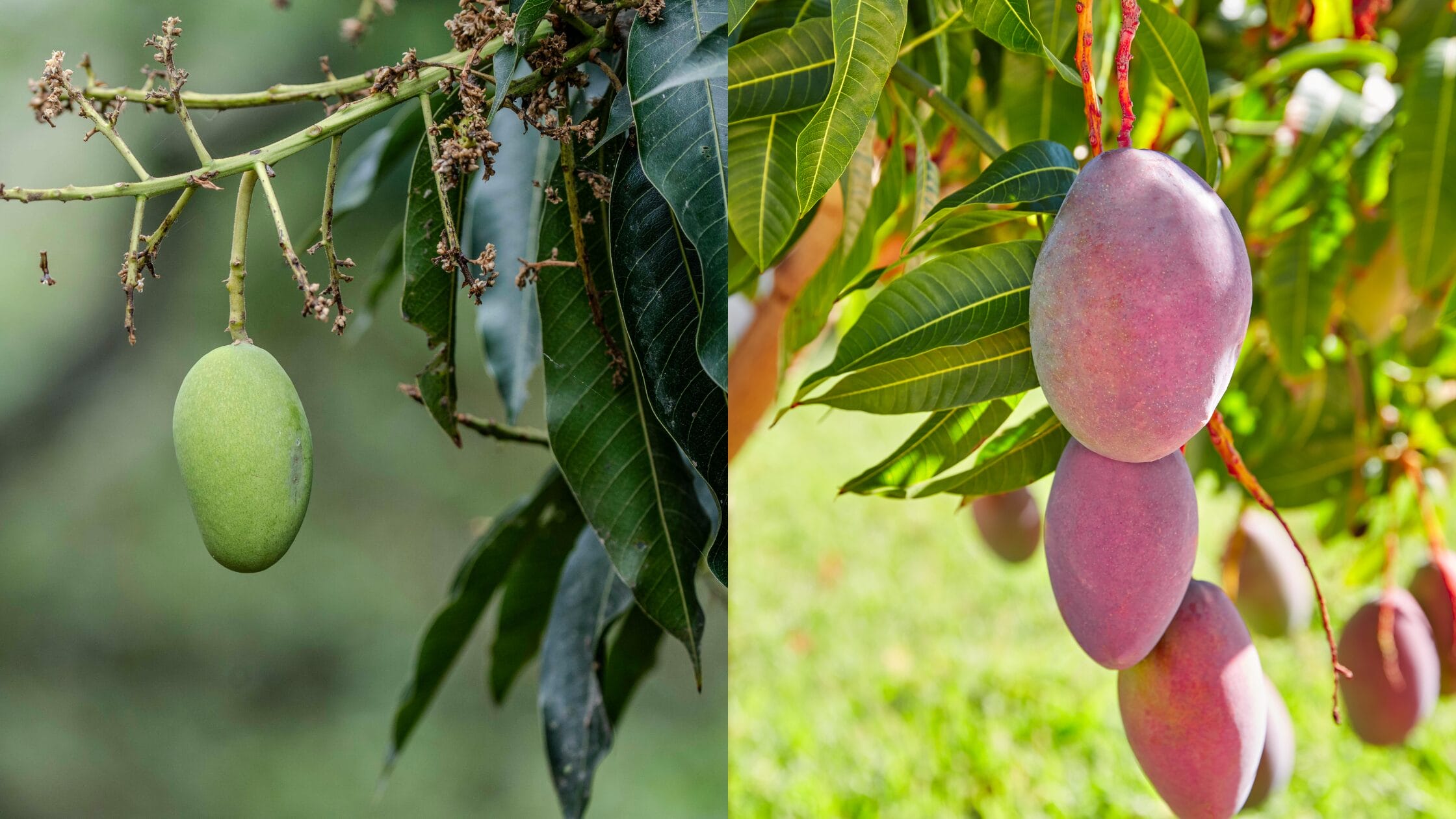About Mango Diseases
Mango (Mangifera indica), known as the “king of fruits,” is a highly valued tropical fruit crop grown across India, Southeast Asia, Africa, and many other tropical and subtropical regions. While mango cultivation can be highly profitable, it is often threatened by various mango diseases and pests that affect yield, quality, and tree health.
Understanding mango leaf diseases, mango tree diseases, and mango plant disorders is essential for farmers, orchard managers, and gardeners to ensure healthy and productive mango trees.
1. Common Mango Leaf Diseases
Mango leaves are highly susceptible to fungal, bacterial, and physiological disorders. Damage to the leaves reduces photosynthesis, weakens the plant, and affects fruit development.
a) Mango Leaf Spot Disease (Anthracnose – Colletotrichum gloeosporioides)
- Symptoms:
- Small brown to black spots on young leaves.
- In severe cases, spots coalesce into large necrotic patches.
- Premature leaf drop and reduced plant vigour.
- Causes: Fungal infection favoured by humid and rainy conditions.
- Management:
- Spray copper-based fungicides or carbendazim at the onset of symptoms.
- Ensure proper pruning to improve air circulation.
- Avoid overhead irrigation to reduce leaf wetness.
b) Powdery Mildew (Oidium mangiferae)
- Symptoms:
- White powdery coating on young leaves, flowers, and panicles.
- Affected leaves curl and dry prematurely.
- Causes: Fungal pathogen thriving in dry days and cool nights.
- Management:
- Apply wettable sulfur or systemic fungicides like triazoles.
- Remove infected plant parts to prevent spread.
c) Mango Leaf Gall
- Symptoms:
- Raised blister-like galls on leaves.
- Reduced leaf size and distortion.
- Causes: Mite infestation (Aceria mangiferae).
- Management:
- Spray miticides like dicofol.
- Maintain orchard hygiene and remove infested leaves.
2. Major Mango Tree Diseases
Mango trees are affected by several fungal and bacterial diseases that can damage branches, trunks, and roots.
a) Mango Malformation Disease
- Cause: Fusarium moniliforme var. subglutinans (fungus) and mite association.
- Symptoms:
- Vegetative malformation: Short, bunchy shoots with small, deformed leaves.
- Floral malformation: Abnormal flower clusters that fail to bear fruit.
- Spread: Through infected planting material and insects.
- Treatment:
- Remove and burn infected shoots.
- Spray carbendazim during the flowering season.
- Use disease-free nursery stock.
b) Bacterial Canker (Xanthomonas campestris pv. mangiferaeindicae)
- Symptoms:
- Raised water-soaked lesions on leaves and fruits.
- Gum oozing from branches.
- Management:
- Copper oxychloride sprays at 0.3%.
- Prune and burn infected branches.
c) Dieback Disease (Botryodiplodia theobromae)
- Symptoms:
- Drying the twigs from the tip downwards.
- Gum exudation from affected areas.
- Treatment:
- Cut infected twigs well below the affected area.
- Apply Bordeaux paste or copper fungicide on cuts.
d) Sooty Mould
- Cause: Growth of fungus (Capnodium mangiferae) on honeydew excreted by sap-sucking insects.
- Symptoms:
- Black sooty coating on leaves, blocking sunlight.
- Control:
- Manage mealybugs, aphids, and scales with neem oil or systemic insecticides.
- Wash affected leaves with a mild detergent solution.
3. Common Mango Pests and Their Damage
Pests often act as vectors for diseases and cause direct damage to mango plants.
| Pest | Symptoms/Damage | Management |
| Mango Hoppers (Idioscopus spp.) | Suck sap from the inflorescence, causing flower drop | Spray imidacloprid or thiamethoxam |
| Mealybugs (Drosicha mangiferae) | Suck sap from shoots, produce honeydew, leading to sooty mould | Soil application of chlorpyriphos, wrap the tree trunk with alkathene sheets |
| Mango Fruit Fly (Bactrocera dorsalis) | Lays eggs in fruits, and maggots feed on pulp | Collect and destroy infested fruits, use methyl eugenol traps |
| Stem Borers (Batocera rufomaculata) | Bore into the trunk, weaken the tree | Remove and destroy infested branches, and inject dichlorvos solution into holes |
4. Integrated Management of Mango Diseases and Pests
To keep mango trees healthy, an Integrated Pest and Disease Management (IPDM) approach is highly effective.
Cultural Practices
- Prune trees regularly to allow sunlight and airflow.
- Remove fallen leaves, infested fruits, and pruned material from the orchard.
- Maintain proper spacing to reduce humidity.
Biological Control
- Introduce beneficial insects like ladybird beetles to control aphids and mealybugs.
- Use bio-fungicides like Trichoderma harzianum in the soil to suppress root pathogens.
Chemical Control
- Use fungicides like copper oxychloride, carbendazim, and mancozeb judiciously.
- Alternate between fungicides with different modes of action to avoid resistance.
- Apply insecticides only when pest populations exceed the economic threshold level.
5. Preventive Measures for Healthy Mango Trees
- Use certified disease-free planting material.
- Disinfect pruning tools with bleach or alcohol after use.
- Apply balanced fertilisers to strengthen plant immunity.
- Irrigate appropriately – avoid waterlogging and prolonged drought stress.
- Mulch around the base to conserve soil moisture and suppress weeds.
6. Quick Guide: Mango Tree Diseases and Treatments
| Disease | Cause | Main Symptom | Treatment |
| Anthracnose | Fungus | Black leaf & fruit spots | Copper fungicide spray |
| Powdery Mildew | Fungus | White powdery coating | Sulfur or systemic fungicide |
| Malformation | Fungus + mites | Deformed flowers/shoots | Remove infected shoots, carbendazim spray |
| Bacterial Canker | Bacteria | Leaf lesions, gum exudation | Copper oxychloride spray |
| Dieback | Fungus | Twigs dry back | Prune & apply Bordeaux paste |
| Sooty Mould | Fungal growth on honeydew | Black coating on leaves | Control sucking insects, wash leaves |
7. Conclusion
Mango cultivation can be highly rewarding, but success depends on effective disease and pest management. Problems like mango leaf spot disease, mango malformation, dieback, and bacterial canker can drastically reduce yield if not controlled on time.
By following integrated management practices, using disease-free planting material, and applying timely treatments, farmers and gardeners can protect their mango trees and enjoy high-quality, abundant harvests year after year.
Healthy mango trees are the result of vigilance, prevention, and prompt action — the perfect recipe for sweet, juicy, and market-ready mangoes.
